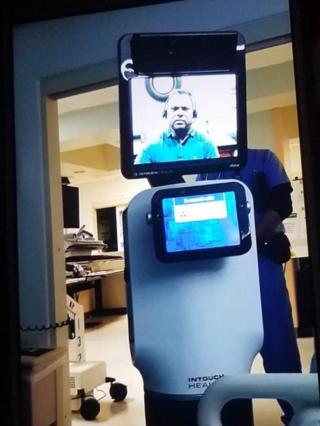Man Told He's Going To Die By Doctor On Video-link Robot
 Image copyright
Julianne Spangler
Image copyright
Julianne Spangler

A doctor in California told a patient he was going to die, using a robot with a video-link screen.
Ernest Quintana, 78, was at Kaiser Permanente Medical Center in Fremont when a doctor - appearing on the robot's screen - informed him that he would die within a few days.
A family friend wrote on social media that it was "not the way to show value and compassion to a patient".
The hospital says it "regrets falling short" of the family's expectations.
Mr Quintana died the next day.
Julianne Spangler, a friend of Mr Quintana's daughter, posted a photo of the robot on Facebook and said it "told [Mr Quintana] he has no lungs left only option is comfort care, remove the mask helping him breathe and put him on a morphine drip until he dies".
She later told BBC News that it was "an extremely frustrating situation", and "an atrocity of how care and technology are colliding".
"I think the technological advances in medicine have been wonderful, but the line of 'where' and 'when' need to be black and white," she added.
Mr Quintana's granddaughter, Annalisa Wilharm, who was with him at the hospital, also told the BBC that she was "trying not to cry".
"I look up and there's this robot at the door," she said, adding that the doctor on the screen "looked like he was in a chair in a room somewhere".
"The next thing I know he's telling him, 'I got these MRI results back and there's no lungs left, there's nothing to work with'. I'm freaking out inside, I'm trying not to cry - I'm trying not to scream because it's just me and him."
She added: "He just got the worst news of his life without his wife of 58 years."
When Mr Quintana's wife arrived, she complained to hospital staff about how the news was broken to her husband. Annalisa Wilharm said that Mr Quintana's wife was told by a nurse "this is our policy, this is how we do things".
Michelle Gaskill-Hames, senior vice-president of Kaiser Permanente Greater Southern Alameda County, said in a statement that its policy was to have a nurse or doctor in the room when remote consultations took place.
"The evening video tele-visit was a follow-up to earlier physician visits," she added. "It did not replace previous conversations with patient and family members and was not used in the delivery of the initial diagnosis."
She added: "That said, we don't support or encourage the use of technology to replace the personal interactions between our patients and their care teams - we understand how important this is for all concerned, and regret that we fell short of the family's expectations.
"We will use this as an opportunity to review how to improve patient experience with tele-video capabilities."
From Chip War To Cloud War: The Next Frontier In Global Tech Competition
The global chip war, characterized by intense competition among nations and corporations for supremacy in semiconductor ... Read more
The High Stakes Of Tech Regulation: Security Risks And Market Dynamics
The influence of tech giants in the global economy continues to grow, raising crucial questions about how to balance sec... Read more
The Tyranny Of Instagram Interiors: Why It's Time To Break Free From Algorithm-Driven Aesthetics
Instagram has become a dominant force in shaping interior design trends, offering a seemingly endless stream of inspirat... Read more
The Data Crunch In AI: Strategies For Sustainability
Exploring solutions to the imminent exhaustion of internet data for AI training.As the artificial intelligence (AI) indu... Read more
Google Abandons Four-Year Effort To Remove Cookies From Chrome Browser
After four years of dedicated effort, Google has decided to abandon its plan to remove third-party cookies from its Chro... Read more
LinkedIn Embraces AI And Gamification To Drive User Engagement And Revenue
In an effort to tackle slowing revenue growth and enhance user engagement, LinkedIn is turning to artificial intelligenc... Read more

